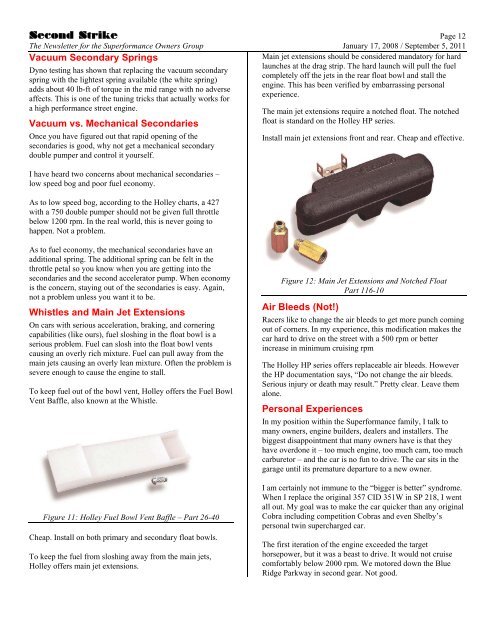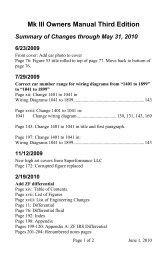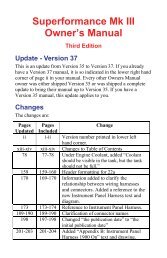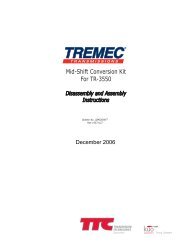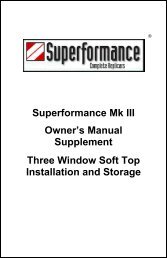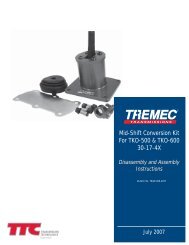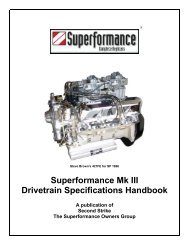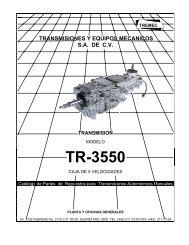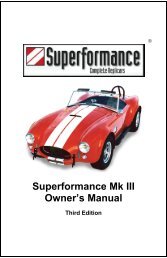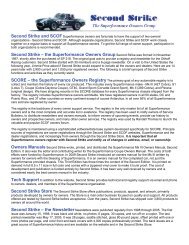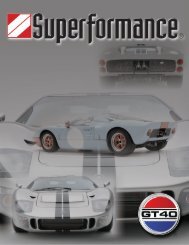Carburetor Calculator - Second Strike
Carburetor Calculator - Second Strike
Carburetor Calculator - Second Strike
You also want an ePaper? Increase the reach of your titles
YUMPU automatically turns print PDFs into web optimized ePapers that Google loves.
<strong>Second</strong> <strong>Strike</strong> Page 12<br />
The Newsletter for the Superformance Owners Group January 17, 2008 / September 5, 2011<br />
Vacuum <strong>Second</strong>ary Springs<br />
Main jet extensions should be considered mandatory for hard<br />
launches at the drag strip. The hard launch will pull the fuel<br />
completely off the jets in the rear float bowl and stall the<br />
engine. This has been verified by embarrassing personal<br />
experience.<br />
Dyno testing has shown that replacing the vacuum secondary<br />
spring with the lightest spring available (the white spring)<br />
adds about 40 lb-ft of torque in the mid range with no adverse<br />
affects. This is one of the tuning tricks that actually works for<br />
a high performance street engine.<br />
Vacuum vs. Mechanical <strong>Second</strong>aries<br />
Once you have figured out that rapid opening of the<br />
secondaries is good, why not get a mechanical secondary<br />
double pumper and control it yourself.<br />
I have heard two concerns about mechanical secondaries –<br />
low speed bog and poor fuel economy.<br />
As to low speed bog, according to the Holley charts, a 427<br />
with a 750 double pumper should not be given full throttle<br />
below 1200 rpm. In the real world, this is never going to<br />
happen. Not a problem.<br />
The main jet extensions require a notched float. The notched<br />
float is standard on the Holley HP series.<br />
Install main jet extensions front and rear. Cheap and effective.<br />
As to fuel economy, the mechanical secondaries have an<br />
additional spring. The additional spring can be felt in the<br />
throttle petal so you know when you are getting into the<br />
secondaries and the second accelerator pump. When economy<br />
is the concern, staying out of the secondaries is easy. Again,<br />
not a problem unless you want it to be.<br />
Whistles and Main Jet Extensions<br />
On cars with serious acceleration, braking, and cornering<br />
capabilities (like ours), fuel sloshing in the float bowl is a<br />
serious problem. Fuel can slosh into the float bowl vents<br />
causing an overly rich mixture. Fuel can pull away from the<br />
main jets causing an overly lean mixture. Often the problem is<br />
severe enough to cause the engine to stall.<br />
To keep fuel out of the bowl vent, Holley offers the Fuel Bowl<br />
Vent Baffle, also known at the Whistle.<br />
Figure 11: Holley Fuel Bowl Vent Baffle – Part 26-40<br />
Cheap. Install on both primary and secondary float bowls.<br />
To keep the fuel from sloshing away from the main jets,<br />
Holley offers main jet extensions.<br />
Figure 12: Main Jet Extensions and Notched Float<br />
Part 116-10<br />
Air Bleeds (Not!)<br />
Racers like to change the air bleeds to get more punch coming<br />
out of corners. In my experience, this modification makes the<br />
car hard to drive on the street with a 500 rpm or better<br />
increase in minimum cruising rpm<br />
The Holley HP series offers replaceable air bleeds. However<br />
the HP documentation says, “Do not change the air bleeds.<br />
Serious injury or death may result.” Pretty clear. Leave them<br />
alone.<br />
Personal Experiences<br />
In my position within the Superformance family, I talk to<br />
many owners, engine builders, dealers and installers. The<br />
biggest disappointment that many owners have is that they<br />
have overdone it – too much engine, too much cam, too much<br />
carburetor – and the car is no fun to drive. The car sits in the<br />
garage until its premature departure to a new owner.<br />
I am certainly not immune to the “bigger is better” syndrome.<br />
When I replace the original 357 CID 351W in SP 218, I went<br />
all out. My goal was to make the car quicker than any original<br />
Cobra including competition Cobras and even Shelby’s<br />
personal twin supercharged car.<br />
The first iteration of the engine exceeded the target<br />
horsepower, but it was a beast to drive. It would not cruise<br />
comfortably below 2000 rpm. We motored down the Blue<br />
Ridge Parkway in second gear. Not good.


